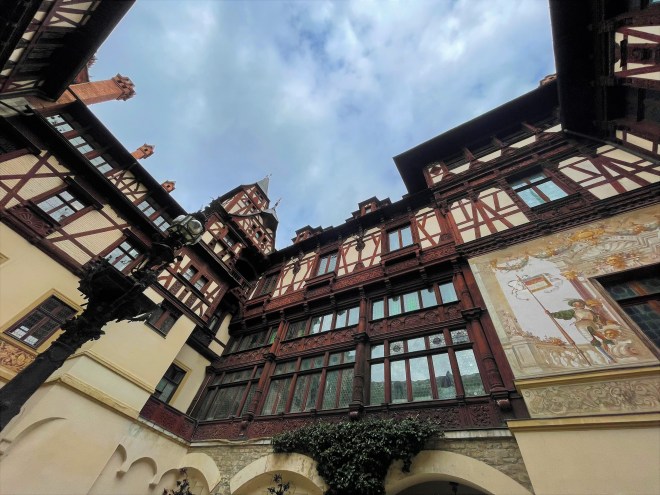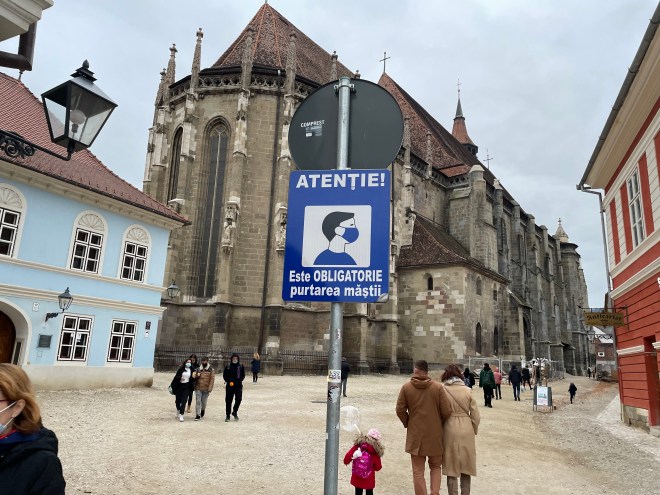
The day trip from Bucharest was ambitious. Touring two castles and Braşov in one day is epic, and a reminder of how frantic day tours can be… Anyway, the castles were grand, and it was a mini-introduction to Braşov, a beautiful medieval town somewhat reminiscent of Novi Sad.

Traffic Hell
I completely forgot to factor in traffic for the two-hour drive from Bucharest. The tour was Saturday, and although we started early, weekend outings were in full swing. Traffic gridlock persisted through the villages all the way to our first stop in Sinaia.

On the way back to Bucharest, traffic was even worse. That aside, the day trip was one of the best I’ve experienced. The group included a driver, guide Vlad – not sure that’s his real name ;o), and 17 extremely pleasant people. We traveled in a comfortable Mercedes van.

Tour Group
The group included German, French, Spanish, Argentinian, and English travelers. I chatted with a couple from Argentina and Spain, currently living in Ireland. After Bucharest, they were headed to Krakow. I spent time talking to another solo traveler from London. We swapped travel tales, and she gave me ideas for my next destination. It’s fun to meet another solo traveler who’s open and shares their experiences in foreign countries. Great to know I’m not the only one who gets lost!

She told me a about a great mapping app – City Mapper. I downloaded it on my iPhone. Depending on which city you’re in, Google Maps can suffer brain damage, meaning prepare yourself, as you might be headed for a surprise adventure!

Peleș Castle Sinaia
Our first stop was Peleș Castle, a magnificent palace built by King Carol I during the 1860s. It’s in the gorgeous Carpathian village-town of Sinaia near hiking trails and ski areas at the foot of the Bucegi Mountains. In terms of size, it’s tiny when compared to King Carol’s other castles. Peleș was a small “summer home” for the king.

The castle took ten years to build, cost $120 million, and has 160 rooms, including a movie theater and concert hall. King Carol is said to have financed Peleș with his own money. The castle’s architecture is Renaissance Revival.
Each room has a theme, and some are decorated to resemble the styles of various world cultures. German sculpted dark wood and elegant stained-glass windows are predominant throughout the castle. As a side note, Peleș is the “first castle in Europe fully powered by locally produced energy”.

Buildings in the castle complex include a power plant, the Economat residence for court employees, royal stables, guards’ chambers, and Foisor hunting lodge with 43 rooms. Additions designed by Czech architect Karel Liman were built between 1893 and 1914.
The inner courtyard is beautiful, especially in autumn when it’s framed by a backdrop of colorful trees. The Great Armory Room with impressive collections of arms, armor, and weaponry was a favorite. The fact that knights and horses could move around wearing all that armor is amazing!

_____________
Beginning in 1883, “King Carol and his wife Queen Elisabeth began spending summers in their fairytale castle, which was also the venue for important meetings during the early months of World War I”.
_____________

The King and his wife were “known to be very different in temperament and interests”. Peleș Castle “reflects their individual personalities”. The king was an “accomplished soldier who greatly expanded and improved the Romanian military”. The queen was more “artistic, with a fondness for music, art, and literature”. She was a writer and poet, using the pen name Carmen Sylva.

Art in the castle includes ceiling frescoes by Austrian artists Gustav Klimt and Franz von Matsch. Other pieces include Chinese vases from the 18th and 19th centuries, Satsuma Japanese pottery, Persian ceramics from the 17th and 18th centuries, and European art from London, Paris, and Vienna. The Old Music Room is furnished with “intricate pieces of teak furniture gifted by the fascinating Maharajah of Kapurtala“.
Peleș History
“After the forced abdication of King Michael I in 1947, Peleș and all properties of the Romanian royal family were seized by the Communist regime. In 1948, the estate was closed, and art was moved to Bucharest Museums.”

King Michael “strenuously opposed the communists’ accession to power in Romania”. After his abdication, he went into exile.

The Communist regime opened Peleș Castle as a museum in 1953. In 1975, it was closed again due to advanced deterioration. Renovations continued between 1975 and 1989. During that time, the castle was “used as a retreat for heads of state visiting Romania”. After the Romanian Revolution of 1989, the castle was reopened to the public. In 2007, it became the property of King Michael I, who died in 2017, at the age of 96.


Bran Castle
Our second stop was medieval Bran Castle. The castle earned its nickname – Dracula’s Castle – because Vlad Tepes Dracula, better known as Vlad the Impaler, was said to have been imprisoned there. Bran Castle is a Romanian national monument and landmark in Transylvania. There are stories about Dracula and the role Bran Castle played in Bram Stoker’s novel and movie.

Vlad the Impaler
Vlad the Impaler ruled during the 15th century. He was known for his bloodlust, including “torturing and impaling his enemies on the battlefield”. He was also “known for his brutal use of the scorched-earth policy, a military strategy that consists of poisoning water supplies and burning crops to destroy any possible resource the enemy could use”.

You can come to your own conclusion about Vlad the Impaler’s link to Dracula by researching it. There seems to be confusion and misinformation about Vlad Tepes’ association with Bram Stoker’s character.

The “description of the castle in Stoker’s novel doesn’t match Bran Castle”. The current “connection between Bran Castle and the Dracula legend (in the sense of Vlad III Dracula and Bram Stoker’s novel) is tourism-driven”.

Vlad Tepes’ entire family was killed by the Ottomans, and he “fought fiercely against the Ottoman Empire”. Vlad ascended the Throne of Wallachia (one of four Romanian provinces) three times – 1448, 1456, and 1474. The Ottomans decapitated Vlad in 1476, and his severed “head was sent to Sultan Mehmed II“.

_____________
“Bram Stoker’s novel, Dracula, is believed to be inspired by the Romanian folklore serial killer Countess Elisabeth Bathory.”
_____________

Bran Castle was built in the 1300s. We spent about 45 minutes there. The grounds are spectacular, and it looks majestic from the outside. The interior is small and pales in comparison to Peleș Castle. The castle seemed more like a tower, with steep, narrow stone passageways between floors. Views from any room in the castle are spectacular!


Queen Marie, Princess Ileana, Dominic von Habsburg
Currently, Bran Castle is “owned by the descendants of Queen Marie, to whom it was given in 1920 as a token of appreciation for her efforts to unify Romania”. After her death, Bran Castle was inherited by her daughter, “Princess Ileana, who ran it as a hospital during World War II”.

In 1948, the Communist regime seized Bran Castle. It was later returned to Princess Ileana’s son, Dominic von Habsburg, and her daughters, Elisabeth Sandhofer and Baroness Maria Magdalena of Holzhausen.

Bran Museum 2009
In June 2009, the Habsburgs opened the refurbished castle to the public, as the first private museum in the country. In collaboration with Bran Village, “they presented a joint strategic concept to maintain their prominent role in the Romanian tourist circuit and safeguard the economic base in the region”.

Braşov Romania
By the time we reached Braşov, it was after 3 p.m. and everyone was famished! Our drop-off point was Old Town Square, where there’s an abundance of cafés and restaurants. I accompanied others, and we picked an Italian restaurant, Dei Frati. They were fully booked. We didn’t want to waste time searching for another restaurant, so we settled for nearby Wagner’s Loft.

The restaurant was packed, and the service was snail-pace slow, but the food was good. After eating, we had only 30 minutes to explore Braşov – ha. It was frustrating, since everyone was interested in several places, including massive, imposing Black Church (Biserica Neagră), the largest Gothic church in Romania.

_____________
“Braşov is fringed by the peaks of the Southern Carpathian Mountains and resplendent with gothic, baroque, and renaissance architecture, as well as a wealth of historical attractions. It’s one of the most visited places in Romania.”
_____________

After our late lunch, there wasn’t enough time to do much, except take photographs. I’m considering spending a few days in Braşov and Sinaia. Problem is, as we approach the holiday season, there will be more and more vacationers headed to these popular areas – especially travel-deprived, covid-antsy tourists! It might be better to remain in Bucharest, as there’s still so much to explore there and soon, they will have fun holiday markets!

Brasov Attractions
This is a list of “must see” attractions in Braşov. It’s an interesting place, so you’ll need at least a few days to take in all the splendor! Braşov “exudes a medieval ambiance and is often used as a backdrop in period films”.
- Old Town – founded in 1211 by Teutonic Knights is situated on an ancient Dacian site; it’s one of the seven walled citadels; Old Town Hall (Casa Sfatului) has a famous watchtower known as Trumpeter’s Tower.
- Rope Street (Strada Sforii) – one of Europe’s narrowest streets
- Council Square (Piata Sfatului) – surrounded by stone walls and seven bastions is said to be the spot where the legendary Pied Piper led the children of Hamelin

- The Black Church (Biserica Neagra) – built 1385 – 1477 is Romania’s largest church and the largest Gothic church between Vienna and Istanbul
- Braşov’s Citadel and Defensive Fortifications – built for protection from invading Mongols and Turks, includes Graft Bastion, White Tower, Black Tower, Blacksmiths’ Bastion, Catherine’s Gate, Weavers’ Bastion, Schei Gate, and Brasov Fortress

- Tâmpa Mountain – the original defensive fortress with a cable car to its peak

- Historic Churches and Monasteries with original Frescoes by muralist Mişu Popp – St. Nicholas Orthodox Church, Braşov St. Nicholas Church, Franciscan Monastery, St. Peter and Paul Roman-Catholic Cathedral, Romanian Orthodox Cathedral, St. Bartholomew Church, St. Martin Church
- Braşov Art and History Museums
More later…







Wow! Romania really has a lot to offer. So happy to see beautiful you with mask off!
What a wonderful day trip but as you allude, trying to fit too much in. Hopefully you can return to Brasov when you have seen enough of Bucharest. I loved the video of Queen Marie.
Brasov looks to be more interesting than Novi Sad. The deciding factor is getting there. After you’ve been traveling for a while and learned a ton of different city transportation systems – or lack there of – it makes you a bit crazy. You really have to think point A to B out in advance, or pay the consequences :o(… I learn that again on each trip. Being back in the US with a car in the garage will seem strange. I wouldn’t even consider driving here – it’s a madhouse! So far, the metro and trams in Bucharest are great, but depending on where you want to go, transfers are involved, and that can get complicated, especially at night! Every time I’ve become complacent, I’m reminded not to be. Not enough time to describe some of the more harrowing experiences getting around in large cities – definitely not for the faint of heart!